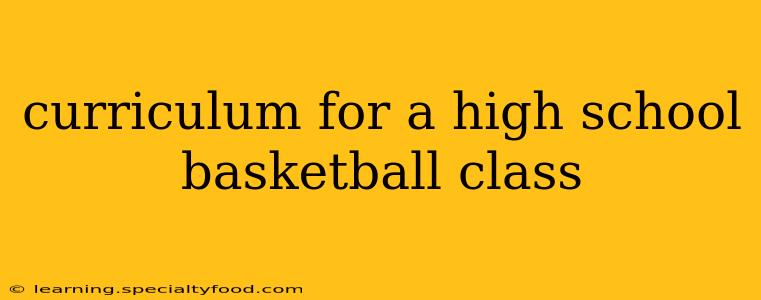This curriculum provides a comprehensive guide for a high school basketball class, blending theoretical knowledge with practical application. It focuses on developing fundamental skills, strategic thinking, and a deep understanding of the game, while also fostering teamwork, sportsmanship, and physical fitness. This curriculum is designed to be adaptable to different skill levels and class durations.
I. Course Overview and Objectives
Course Description: This course provides a comprehensive introduction to the sport of basketball, covering fundamental skills, offensive and defensive strategies, rules, history, and the importance of teamwork and sportsmanship. Students will participate in both individual and team drills, scrimmages, and discussions to enhance their understanding and skill development.
Course Objectives: Upon successful completion of this course, students will be able to:
- Demonstrate proficiency in fundamental basketball skills (dribbling, passing, shooting, rebounding, defense).
- Understand and apply basic offensive and defensive strategies.
- Comprehend and follow the rules of basketball.
- Appreciate the history and cultural impact of basketball.
- Exhibit good sportsmanship and teamwork skills.
- Improve cardiovascular fitness and overall physical health.
II. Unit Breakdown
This curriculum is broken down into units, each focusing on a specific aspect of basketball:
Unit 1: Fundamentals (4 Weeks)
- Dribbling: Basic dribbling techniques, crossover dribbles, between-the-legs dribbles, behind-the-back dribbles.
- Passing: Chest passes, bounce passes, overhead passes, baseball passes.
- Shooting: Proper shooting form, free throws, jump shots, layups.
- Rebounding: Offensive and defensive rebounding techniques, boxing out.
- Footwork: Pivoting, defensive slides, proper stance.
Unit 2: Offensive Strategies (3 Weeks)
- Offensive Sets: Basic offensive formations (e.g., pick-and-roll, high-low post), motion offense.
- Ball Movement: Importance of passing and creating scoring opportunities for teammates.
- Cutting and Screening: Effective cutting to the basket and setting screens for teammates.
- Post Play: Fundamentals of post moves (e.g., hook shot, drop step).
Unit 3: Defensive Strategies (3 Weeks)
- Defensive Stance: Proper defensive posture and footwork.
- Man-to-Man Defense: Individual defensive techniques, staying in front of your opponent.
- Zone Defense: Understanding and implementing various zone defenses (e.g., 2-3 zone, 1-3-1 zone).
- Help Defense: Rotating and assisting teammates on defense.
Unit 4: Rules and Officiating (2 Weeks)
- Basic Rules: Understanding the fundamental rules of the game (e.g., traveling, double dribble, fouls).
- Fouls: Different types of fouls (e.g., personal fouls, technical fouls), their impact on the game.
- Officiating: Understanding the role of basketball referees and the challenges of officiating. (Optional: Guest speaker - a basketball referee)
Unit 5: History and Culture of Basketball (2 Weeks)
- History: Tracing the evolution of basketball from its origins to its current global popularity.
- Cultural Impact: Exploring the role of basketball in different cultures and communities.
- Famous Players and Teams: Discussing influential figures and teams throughout basketball history.
Unit 6: Fitness and Conditioning (Ongoing)
- Warm-up and Cool-down: Importance of proper warm-up and cool-down routines.
- Cardiovascular Exercise: Running, agility drills, and other cardiovascular activities to improve stamina.
- Strength Training: Exercises to build strength and power, important for basketball performance.
III. Assessment
Assessment will be based on a variety of methods, including:
- Skill Demonstrations: Students will be assessed on their proficiency in fundamental skills.
- Participation: Active participation in class activities and scrimmages.
- Written Assignments: Essays, research papers, and quizzes on rules, strategies, and history.
- Teamwork and Sportsmanship: Observed during class activities and games.
- Fitness Tests: Measuring improvement in cardiovascular fitness and strength.
IV. Resources
- Basketballs
- Cones
- Scoreboard
- Videos of basketball games and instructional videos
- Library resources on basketball history and strategy
This curriculum provides a framework for a successful high school basketball class. The specific content and emphasis can be adjusted to meet the needs and interests of the students and the available resources. Remember to prioritize safety and encourage a positive and inclusive learning environment.
